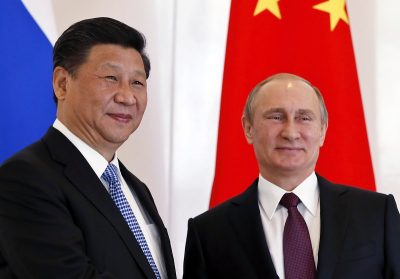The China-Russia Strategic Partnership

All Global Research articles can be read in 51 languages by activating the “Translate Website” drop down menu on the top banner of our home page (Desktop version).
To receive Global Research’s Daily Newsletter (selected articles), click here.
Visit and follow us on Instagram at @crg_globalresearch.
***
The state of their bilateral relations is now indeed a model of effective inter-state interaction in the 21st century exactly as President Putin described them. They trust one another, treat each other as equals, and prioritize political solutions over saber-rattling and rumor-mongering. This is the exact opposite of the US’ relations with the rest of the world.
President Putin said earlier this month that “Some Western partners are blatantly trying to drive a wedge between Moscow and Beijing, but this is obvious for us and together with our Chinese friends we will further respond by expanding cooperation in politics, the economy and other areas and will coordinate steps on the international arena.” This is because Chinese-Russian relations “are a model of effective inter-state interaction in the 21st century.” These observations will now be elaborated upon.
Regarding President Putin’s warning, it’s become increasingly clear that the US is attempting to “triangulate” between itself, China, and Russia. After all, American media and think tanks openly spoke about this ahead of last June’s summit between Presidents Putin and US President Joe Biden in Geneva. They built upon prior fake news narratives to wildly speculate that Russia might somehow be tempted to go against China in exchange for limited relief from the US-led Western pressure upon it.
Not only did that never happen, but it’s also absurd to countenance. That’s because the Chinese-Russian Strategic Partnership is mutually beneficial. Their leaders share the same worldview with respect to jointly accelerating the emerging multipolar world order. Chinese President Xi Jinping and his Russian counterpart adhere to international law and support the UN’s central role in International Relations. Their countries’ economies are also mutually complementary and there exist no bilateral disputes.
Everything could have been very different around the end of the Cold War. China and the erstwhile Soviet Union had a falling out a few decades prior. They even clashed along their then-disputed frontier on several occasions. Instead of being swayed by Western ill-wishers, they responsibly decided to discuss their problems and ultimately founded what’s now known as the Shanghai Cooperation Organization (SCO), which is Eurasia’s premier socio-economic and security organization.
The resultant state of their bilateral relations is now indeed a model of effective inter-state interaction in the 21st century exactly as President Putin described them. They trust one another, treat each other as equals, and prioritize political solutions over saber-rattling and rumor-mongering. This is the exact opposite of the US’ relations with the rest of the world. It doesn’t even trust its NATO allies since it’s been caught spying on them several times before, it treats them as vassals, and always pressures them.
Just this last May, for example, it was reported that Denmark helped the US spy on outgoing German Chancellor Angela Merkel from 2012-2014. This is in spite of Germany hosting more US military forces than any other NATO country. Expanding on the reality of German-US relations, Washington has also sought to unsuccessfully coerce Berlin into canceling the Nord Stream II pipeline with Russia. Furthermore, it’s tried to pressure its ally into curtailing its trade and investment ties with China.
This politically inconvenient reality is emblematic of how the US treats its so-called allies. America’s attitude towards those dozens of other countries that are less strategically important for it than Germany is even worse, but highlighting how it abuses Berlin is instructive for showing that even its “highest standard” in bilateral relations falls far short of the standard set by Chinese-Russian relations. One can only imagine how terribly the US treats its African and Latin American partners.
By contrast, China and Russia employ the exemplary model of inter-state relations that they pioneered with one another in all of their other foreign partnerships. This naturally includes those African, Asian, European, Latin American, and Oceanic countries that the US always mistreats. The emerging model of International Relations being led by those two major countries is accelerating the multipolar world order exactly as their leaders envision. This is in turn helping to stabilize global affairs.
While some observers have high hopes that the US might learn from those two for pragmatism’s sake, that’s unlikely to happen. Instead of applying the lessons that China and Russia are teaching the world, the US stubbornly continues to cling to its counterproductive model of aggressively imposing its hegemony on all others. The more independently that its so-called allies behave, the more pressure that it puts upon them as evidenced by the earlier explained German example.
The American model is therefore strategically unsustainable. It cannot continue to uphold its influence by coercion, threats, and even sometimes force. The international community is taking the opportunity to embrace the pragmatic multipolar model jointly spearheaded by China and Russia in order to collectively forge a community of common destiny for mankind. It’s only a matter of time before the US isolates itself, but before then, it can be expected to make a lot of trouble for its own allies.
*
Note to readers: Please click the share buttons above or below. Follow us on Instagram, @crg_globalresearch. Forward this article to your email lists. Crosspost on your blog site, internet forums. etc.
This article was originally published on OneWorld.

